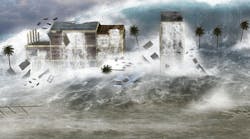When workers are hired, their first days, weeks or even months may be spent learning how to do their jobs correctly. This training often is multi-faceted and can include everything from where to put their personal belongings to learning in-depth procedures that will keep them safe while performing dangerous tasks.
It can be easy to focus on ensuring that standard procedures are in place, up-to-date and being followed. As long as everything runs according to plan, the facility can remain safe and productive. However, that not always is the case.
Emergencies disrupt normal business routines, and just like daily operations and procedures, having a response plan is the first step to help everyone know what to do when the unexpected happens. Just like training workers to do their daily job duties, they need to learn what to do when things don’t go as planned.
Emergency response plans need to cover a wide variety of hazards. They also account for the resources needed for response, as well as the specific actions that will be taken to mitigate various situations that could occur. There are five planning “Ps” that could assist managers with the process of planning and prevention.
Predict
The days of saying “I never expected that to happen” are gone. As potential emergencies are identified, prepare and plan for all of the things that no one likes to think about such as fires, natural disasters and business attacks. Although these and many other types of emergencies occur can without warning, they still are predictable.
Emergencies may occur within a facility or they may affect an entire region. Knowing what could happen establishes the scope for planning and other preparations. It also can prevent the facility from preparing for a disaster that is unlikely instead of preparing for something that far more likely is to happen.
The Federal Emergency Management Agency (FEMA), the American Red Cross and other organizations offer free information to help businesses become aware of the types of disasters and emergencies that they may face. They also offer templates to help facilities begin planning.
Prepare
Responding to a fire is different than responding to a tornado. Different actions and different resources are needed for each of these scenarios. Preparation for both situations involves having the right resources and assigning roles and responsibilities.
Emergency response planning helps everyone at an organization decide on appropriate actions. This preparation begins with stocking response supplies. This is where knowing what could happen is important, because those resources will need to be put somewhere and periodically checked to make sure that they still are in working order. It doesn’t make sense to stock things that aren’t likely to be needed.
Sometimes, it may not make sense to stock certain types of supplies, especially those that are expensive or won’t be used very often. It might make more sense to coordinate response with an outside agency that already owns that equipment and has the manpower and training to use it – especially for smaller facilities with limited resources. Firefighting and responding to emergency chemical releases are two examples.
Physical stockpiles only are half of the equation. Readiness also includes everyone understanding the risks involved and having the proper level of training to perform the tasks needed taken to mitigate an emergency.
Planning also needs to include ways to communicate with employees, families, outside responders, mutual aid groups, stockholders, vendors, customers and the media. Maintaining organizational charts with contact information can seem like a never-ending task, but it is a critical element of emergency planning.
Protect
Life safety is a key principle of every emergency response. Plans should describe how the facility intends to protect their employees during emergencies and how response resources will be utilized.
Just like standard operating procedures detail the steps to be taken to perform work tasks safely, emergency response plans need to outline what procedures they expect employees to follow when anything out of the ordinary happens.
Response duties may include evacuating, sheltering in place or taking a more active response role. Regardless of the level of involvement, procedures should be developed for all types of employees. They also should have provision for ensuring the safety of visitors and the surrounding community.
Practice
High-performing employees often are the ones who have the most experience in their fields. Chances are good that they’re veteran employees who have done their jobs for several years. They’ve had a lot of practice.
Employees can’t be expected to respond to emergencies instinctively. They need to be trained on their specific roles and given opportunities to perform those roles. Even though emergency response skills won’t be used daily, those abilities need to be utilized often enough that when the time comes, everyone can recall them and act instinctively.
Training and drills take time, but they give everyone the chance to get things right before they are in a critical situation. Drills also can identify plan shortcomings so that they can be corrected before an emergency. Allow time after drills for everyone to comment on what worked as well as areas where people may need further training.
Patrol
Emergency response plans are living documents. Like standard operating procedures, they need to be updated when things change.
Although it may not be a regulatory requirement, annual plan reviews often will uncover updates and changes that need to be made. Responding to comments made after drills also can help make plans better and easier to follow.
Few response plans are perfect, but that doesn’t mean they aren’t essential or that they won’t help the facility be prepared for emergencies. Establishing procedures, stocking response resources and providing employees with the training and skills they need to respond will help them to develop the confidence they need to respond safely in emergencies.
Karen Hamel, CSP, WACH, is a regulatory compliance specialist and technical writer at New Pig Corp.
